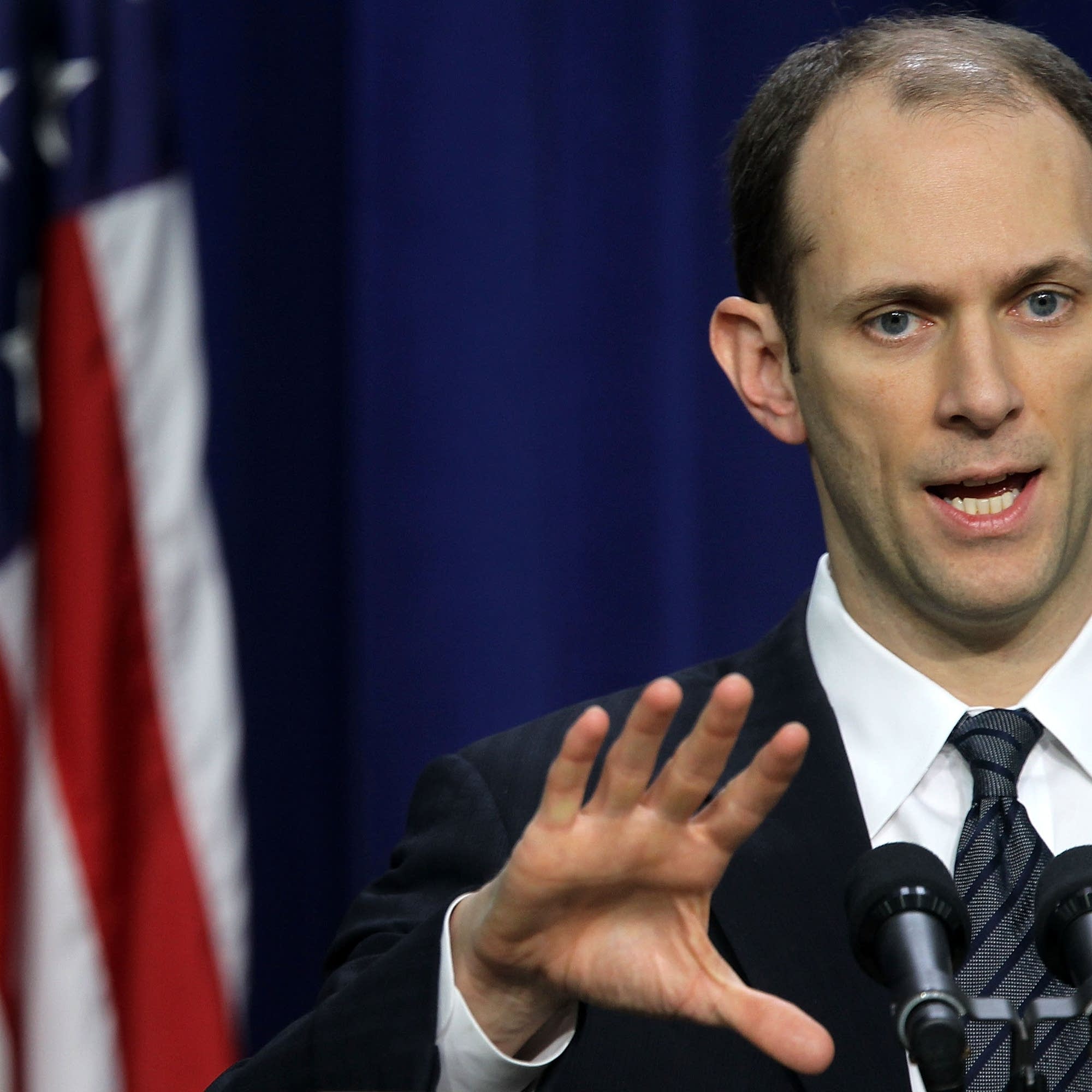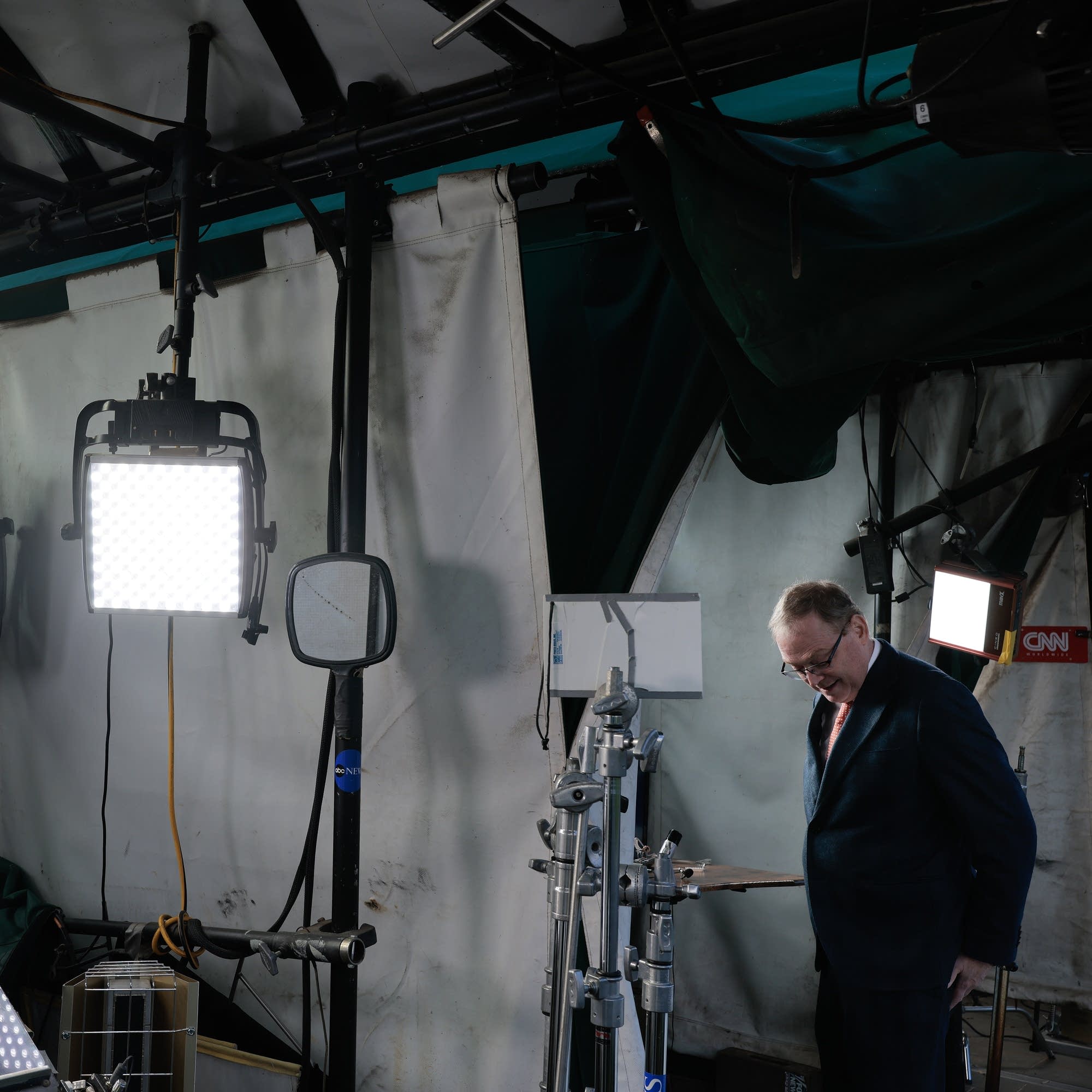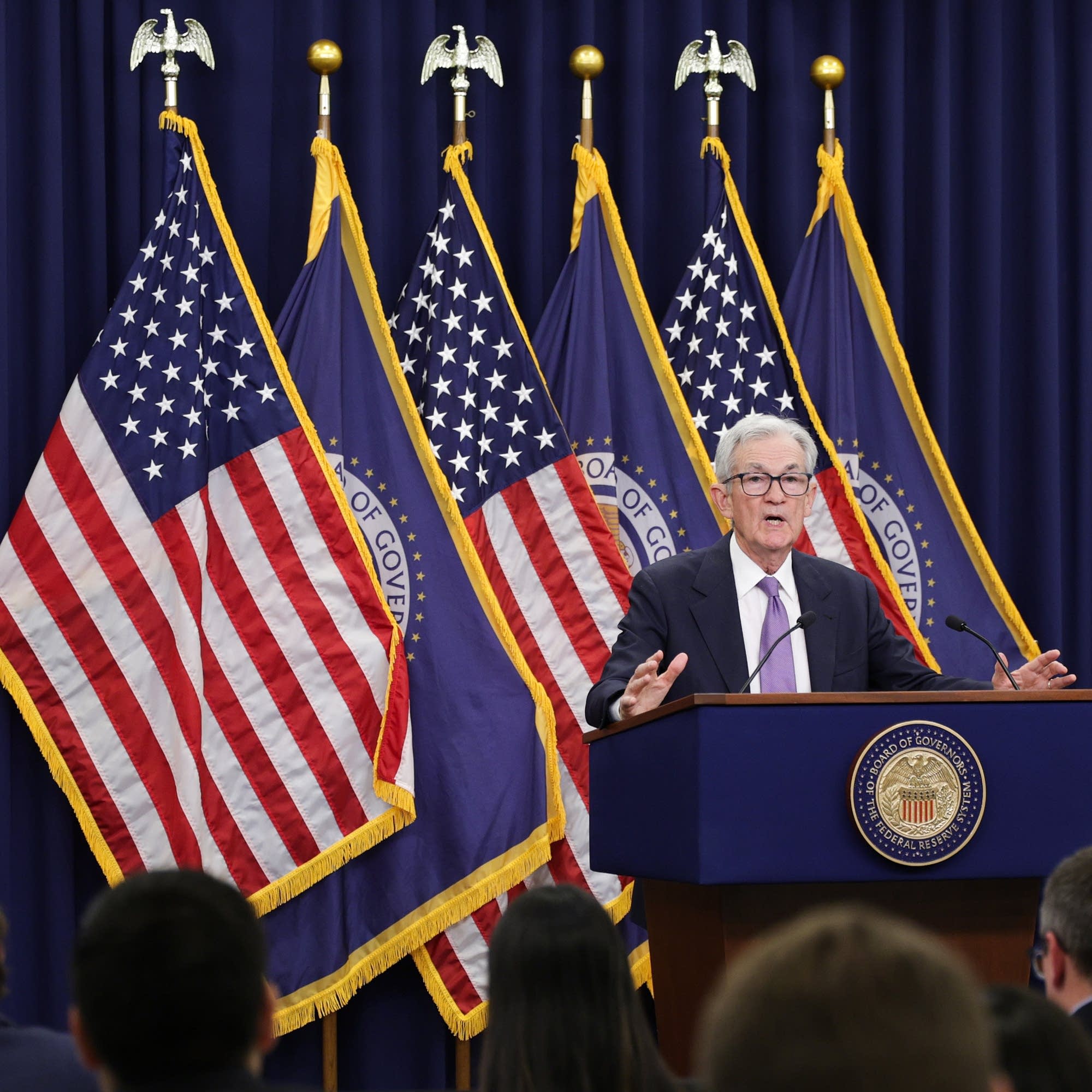The data dogs are howling
The government shutdown means crucial jobs data will likely be postponed, right as the Fed weighs its next move. Chicago Fed President Austan Goolsbee, a self-described “data dog,” tells us how central bank officials plan to pivot. He also discusses Fed independence, transitory inflation, and rate cut pacing. After that: fiscal calendars vary by sector, synthetic dye removal will ripple through the food chain, and ADP reports more sour employment data.
Every story has an economic angle. Want some in your inbox? Subscribe to our daily or weekly newsletter.
Marketplace is more than a radio show. Check out our original reporting and financial literacy content at marketplace.org — and consider making an investment in our future.
Press play and read along
Transcript
Speaker 1 podcast is sponsored by Talkspace. You know, when you're really stressed or not feeling so great about your life or about yourself, talking to someone who understands can really help.
Speaker 1 But who is that person? How do you find them? Where do you even start? Talkspace. Talkspace makes it easy to get the support you need.
Speaker 1 With Talkspace, you can go online, answer a few questions about your preferences, and be matched with a therapist.
Speaker 1 And because you'll meet your therapist online, you don't have to take time off work or arrange childcare. You'll meet on your schedule, wherever you feel most at at ease.
Speaker 1 If you're depressed, stressed, struggling with a relationship, or if you want some counseling for you and your partner, or just need a little extra one-on-one support, Talkspace is here for you.
Speaker 1 Plus, Talkspace works with most major insurers, and most insured members have a $0 copay. No insurance?
Speaker 3 No problem.
Speaker 1
Now get $80 off of your first month with promo code Space80 when you go to TalkSpace.com. Match with a licensed therapist today at TalkSpace.com.
Save $80 with code SPACE80 at talkspace.com.
Speaker 4 This podcast is supported by Odo. Some say Odo business management software is like fertilizer for businesses because the simple, efficient software promotes growth.
Speaker 4 Others say Odoo is like a magic beanstalk because it scales with you and is magically affordable.
Speaker 4 And some describe Odo's programs for manufacturing, accounting, and more as building blocks for creating a custom software suite. So Odoo is fertilizer, magic beanstock building blocks for business.
Speaker 4
Odoo, exactly what businesses need. Sign up at odoo.com.
That's odoo.com.
Speaker 6
Shut down or the federal reserve. Shut down or the federal reserve.
We're going to go federal reserve. From American public media, this is Marketplace.
Speaker 6
In Los Angeles, I'm Kai Rizdahl. It is Wednesday today.
This one is the first of October. Good as always to have you along, everybody.
Speaker 6 Interestingly, the macroeconomic story of this Wednesday is not the government shutdown.
Speaker 6 It is bad, and it is not a great way to run the world's most important economy, but big picture, it is probably just going to be a ripple.
Speaker 6 The big picture big news is that the Supreme Court this morning said Lisa Cook can stay at the Federal Reserve at least until it hears arguments in that case in January and then decides.
Speaker 6 So it's lucky for us that we were able to get another Fed official on the phone today. Austin Goolsby is the president and CEO of the Federal Reserve Bank of Chicago.
Speaker 6 Austin, welcome back to the program.
Speaker 5 Kai, great to talk to you again.
Speaker 6 I have to start with the Lisa Cook News. Obviously, the Supreme Court this morning, as I said in the introduction, is letting her stay in the office at least till arguments on this case in January.
Speaker 6 I'm going to, I really dislike prefacing questions, but I kind of have to at this point.
Speaker 6 Every time I ask a Fed governor or a regional Fed president like yourself about the politics of this economy, the invariable answer is it doesn't affect things at all.
Speaker 6 It is simply not believable that the tumult around the Federal Reserve in politics right now with Stephen Mirren and Governor Cook is not at least somewhere in your mind.
Speaker 7 Discuss.
Speaker 5 Well,
Speaker 5
let's separate two different things. One is what drives FOMC decisions around the table when we're setting interest rates.
And there,
Speaker 5 everyone takes the job extremely seriously. And what drives interest rate decisions is the economic outlook and the data and what the economic conditions are.
Speaker 5 In this, I'm not a lawyer.
Speaker 5 I don't know anything about the cases that are being made or going to Supreme Court. I do know that the Fed needs to be independent from political interference when setting interest rates.
Speaker 5 It's as simple as that.
Speaker 6 Aaron Powell, do you worry that that independence is at risk now?
Speaker 5 I I don't worry because, A, I'm not a worrier type, but B,
Speaker 5 as I say, when you sit around the table at the FOMC, my observation is people take the job extremely seriously.
Speaker 5 And so
Speaker 5 I have no reason to think that won't continue. All right.
Speaker 6 Let me get you back into your comfort zone. And I ask you this question as you have described yourself many a time on this program as a data dog.
Speaker 6 We are, as you know, in the middle of a government shutdown, early stages.
Speaker 6 We are not going to get the jobs number on Friday. You are a data dog.
Speaker 6 How worried are you about the shutdown in this economy and your ability at the central bank to figure out what the heck is going on?
Speaker 5 Yeah, look, the data dogs are howling because
Speaker 5 we're not getting our usual supply of information. I will say
Speaker 5 I consider the Bureau of Labor Statistics job data to be the absolutely best data source on jobs and statistics in the entire world. If we aren't going to have those, it's problematic.
Speaker 5 That said, the Chicago Fed has come out with some new job market indicators, and we'll be releasing them tomorrow, which
Speaker 5 give a real-time forecast of the unemployment rate using 11 different sources, some private, some public.
Speaker 5 It will allow us to say what the unemployment rate would have been.
Speaker 5
And kind of one of the key rules of the data dogs is sniff every piece of data that hits the floor because it might be food. And so that's what we're going to have to do.
I mean,
Speaker 5 the best number is the BLS number. But if we don't have that, we're going to use the Chicago Fed numbers and other numbers.
Speaker 6 Perfect timing, actually, for you guys to be rolling this thing out.
Speaker 5 Let me ask you, though,
Speaker 6 about
Speaker 6 the job market, because you have said in a speech or in some remarks the other day, and this is just an observable fact, we are in a low hiring, low firing environment, right?
Speaker 6 There's not a lot of stuff going on there because consumers and mostly employers are really nervous. What do you make of that?
Speaker 5 Yeah, that's an unusual situation to be in. And that's one of the things that I've been trying to highlight is that's not a normal recession.
Speaker 5 So if you looked at payroll employment and saw it going down,
Speaker 5 normally, if that were the beginning of a recession, you would expect that the layoffs would be going up. But layoffs aren't really going up, but the hiring rate is low.
Speaker 5 I do think
Speaker 5 some significant part of that is the natural result of uncertainty, that there's a lot of stuff going on.
Speaker 5 That as I'm out here in the 7th district talking to business leaders, they're still saying, well, we're trying to get clarity of where the tariff rates are going to end up, what's going to be exempted.
Speaker 5 There are a bunch of question marks that people are sitting on their hands a little bit, and that contributes to an environment where they're not letting people go, but they don't want to hire people either because
Speaker 5 they want to get some clarity.
Speaker 6 Yeah, in plain English, people aren't sitting on their hands. Does not economic activity make?
Speaker 5 Yeah, true.
Speaker 5 Yet at the same time, a lot of times what we'll do is go look at the most cyclically sensitive interest rate sensitive parts of the economy as the canary in the coal mine to tell you, where are we in the business cycle?
Speaker 5 That's normally business investment, consumer durables, housing construction, and we're getting a mixed picture. If you look at that, business investment is actually pretty strong.
Speaker 5
Consumer spending overall has been surprising, looking surprisingly strong so far, even for the third quarter. Housing construction is the weak spot in there.
So we got some cross currents.
Speaker 5 And going into a period where you're trying to figure out is this a transition and then you're not going to get the data is just that much harder. Yeah.
Speaker 6 You have talked about being worried about
Speaker 6 cutting interest rates too fast, too early. So given all that you've said to me this morning and that sort of belief that you have, which side of the mandate do you come down on now?
Speaker 6 Are you more worried about jobs or are you more worried about price stability?
Speaker 5 I'm worried about that. That's very about both.
Speaker 5 Yeah.
Speaker 5 I guess
Speaker 5 my concern is we've been four and a half years above the inflation target. And
Speaker 5 when inflation was shrinking and it felt pretty comfortably to me, like we're on path to 2%,
Speaker 5 I was, as you know, pretty out front saying I think rates can keep coming down. I still feel that way, but I'm starting to get a little more concerned when inflation is going the wrong way.
Speaker 5 We've been four and a half years above 2%,
Speaker 5 and now inflation is rising.
Speaker 5
And counting on that inflation will probably be transitory and just go away. Given the history of the last three or four years, that makes me nervous.
And
Speaker 5 while the Bureau of Labor Statistics is down, let's remember those are the folks who also tell us the inflation readings.
Speaker 5 And while we have some other indicators of the job market, we don't have that many indicators about inflation.
Speaker 5 And that we started to see a kind of a disturbing uptick in services inflation, which is not really likely to be driven by tariffs.
Speaker 5 That is an area of concern at the least.
Speaker 6 You know, I was going to let you go, but then you went and used the word transitory, which honestly coming out of the mouth of a central banker is a gutsy move, man.
Speaker 5 And I should have whispered it.
Speaker 6
Right. You totally should have.
Do you believe that these tariff impacts will be transitory on the price level?
Speaker 5 I certainly hope so. You know, the theoretical argument is if it's a one-time, one-and-done tariff, that would increase the price level and it would not be a lasting inflation shock.
Speaker 5 But the thing is, so far it hasn't been won and it is not done. So I think we want to be a little,
Speaker 5 I think we want to be a little careful.
Speaker 5 I still think the underlying economy is a pretty strong economy and that we can get rates down a fair amount. I just don't, I want us to be careful overly front loading before we have the evidence.
Speaker 6
Austin Goolsby at Chicago Fed. Thanks, Austin.
It's always good to have you on.
Speaker 5 Guy, great talking to you again.
Speaker 6 On Wall Street today, well, let's see. A government shutdown? Weaker than expected labor market news?
Speaker 5 What?
Speaker 6 Me worry? We'll have the details when we do the numbers.
Speaker 6 If you are perchance wondering why all of this shutdown, Michigan is happening right now, October the 1st is basically New Year's Day for the federal government's finances, the beginning of its fiscal year 26, which will run through the end of September 2026.
Speaker 6 And Washington isn't the only one whose budget doesn't work on that traditional January to December timeline. Lots of private companies do it too.
Speaker 6 So,
Speaker 5 why?
Speaker 6 Here's Marketplace with Matt Levin. There's not a lot of partying for federal fiscal new year.
Speaker 3 No ball drop from the top of the Congressional Budget Office. No Ryan Seacrest broadcast from the roof of the IRS.
Speaker 3 University of Maryland federal budget expert Phil Joyce didn't even stay up till midnight last night.
Speaker 8 It's not really much of a celebratory event because we usually haven't done the things we need to do by the beginning of the fiscal year.
Speaker 8 So it's a little bit more of an opportunity to commemorate failure than it is success.
Speaker 3 Congress decided in 1974 to push the beginning of the fiscal year back to October 1st to give it more time to deliver a budget.
Speaker 3 Joyce says even if Congress has only met that October 1st deadline four times, starting the fiscal new year on the actual calendar new year would be a bigger headache.
Speaker 8 If the fiscal year started on January 1st,
Speaker 8 then it would be December when we were having all these sort of machinations around, you know, trying to approve the budget.
Speaker 3 While they disagree on just about everything else, neither Republicans nor Democrats want to work the holidays.
Speaker 3 Those holidays are are when big box retailers do most of their business, which is why companies like Target and Walmart end their financial year January 31st.
Speaker 3 Mike Bellen is at accounting and consulting firm PWC.
Speaker 9 I think it's for peace of mind that many of those companies have chosen a 131 to make sure they are capturing the revenues, returns, activity for that really busy period and they kind of have the peace of mind to close the books at January 31st.
Speaker 3 Doing year-end financial results during the holiday rush is just too much work. So companies at a month of breathing room.
Speaker 3 Even if a company wants to change its fiscal year, it might also have to change other aspects of the business, like its performance review schedule.
Speaker 9 There's a lot more to think about outside of just financial reporting, tax, legal, operational matters, employee matters that have to be considered. So it is pretty heavy lift.
Speaker 3 And private companies can't postpone their budget deadlines as easily as Congress apparently can. I'm Matt Levin for Marketplace.
Speaker 6 Here's a story about how scale really does matter. Walmart says it's going to remove synthetic food dyes and some other additives from all of its store brands by 2027.
Speaker 6 That's private labels like Better Goods and Great Value, which is, as it happens, the most popular in-store brand in America. Walmart says 90% of its products are already free of those additives.
Speaker 6 But as Marketplace Megan McCarty-Carina reports, even a 10% change for a retailer as big as Walmart, that's a big deal.
Speaker 2 Walmart dominates grocery sales in the U.S., and its competitors aren't even close. The retailer gobbles up almost a quarter of the market share, says analyst Arun Sundaram at CFRA Research.
Speaker 11 So there's a pretty large gap between Walmart and the rest of the grocery industry.
Speaker 2 He says their private labels have been a driver of growth in recent years as inflation-weary consumers hunt for deals. So any changes to those products are sure to make waves.
Speaker 11 It's a sign
Speaker 11 of where consumers are heading, where grocery retailers are heading, and we're probably going to skier other retailers follow suit.
Speaker 2 Walmart has transformed the food landscape before, like when it leaned into organics in the mid-2000s. Phil Lempert at Supermarket Guru says Walmart helped bring that once niche market mainstream.
Speaker 10 It blew it up. Now about 80% of all consumers buy some organic foods, and a lot of them are buying it from Walmart.
Speaker 2 But the surge in demand for organic products also blew up the supply chain of what had been mostly smaller-scale farms, says Marion Nessel, professor emeritus of nutrition and food studies at NYU.
Speaker 12 Well, it became industrialized, and the big producers pushed the Organic Standards Board to relax requirements.
Speaker 2 The sudden switch to natural food colorings could also challenge supply chains, says David Schoeneker, a food industry consultant and former president of the International Association of Color Manufacturers.
Speaker 2 Take, for instance, carmine, a natural substitute for synthetic red dye used in sauces and baked goods.
Speaker 13 Carmine is made from the female cochineal insect that only grows on cactuses in Peru, the Canary Islands, and a little bit in Mexico. Okay, there's only so many of those cactuses.
Speaker 2 He says more competition for natural dyes like carmine could mean higher prices for red velvet cake. I'm Megan McCarty-Carino for Marketplace.
Speaker 6 Coming up.
Speaker 7 It could be used to fund sidewalks or infrastructure.
Speaker 6
It is the Community Development Block Grant. But first, let's do the numbers.
Dow Industrial is up 43 points today, about a 10th percentile, 46,441. The NASDAQ up 95 points, 4 tenths percent, 22,755.
Speaker 6
The SP 500 tacked on 22 points, about 3 tenths percent, 6711. Matt Levin was talking about the whole concept of the fiscal year.
Apple just started a new fiscal year as well.
Speaker 6
It gained 3 tenths percent. Today, Disney also rang in a new fiscal.
Its shares went the other way down 1.3% to start its Y, its FY26.
Speaker 6 Megan McCarty-Carino was talking about Walmart and synthetic dyes. Shares of the Bentonville Behemoth were in the red, losing 1%.
Speaker 6 Today, you're listening to Marketplace.
Speaker 5 Recruitment.
Speaker 14 In law, it can feel clinical, procedural, lacking the human element that defines the profession. LHH believes it should be more.
Speaker 14
By connecting legal talent to meaningful opportunities, not just matching skills to job descriptions. Beautiful things happen in legal careers.
A mentor shapes a future. A team argues, then aligns.
Speaker 14
The associates you hire become the advocates you trust. Making the thousands of hours in practice truly matter.
Recruitment, development, career transition.
Speaker 14 LHH, a beautiful working world for the legal world.
Speaker 14 Discover recruitment solutions today at LHH.com slash beautiful.
Speaker 6 This Marketplace podcast is sponsored by the University of Illinois Geese College of Business. For many, the next step in their career is an MBA, but finding the time and budget can be a challenge.
Speaker 6 The University of Illinois Geese College of Business offers their online MBA, the IMBA. It's fully online, flexible, and delivered at a fraction of the cost of a traditional MBA.
Speaker 6 Students get the same world-class Illinois faculty and an interactive global network all designed to fit their lives. To learn more about the Geese IMBA, visit
Speaker 6 MBA.illinois.edu. That's online MBA.edu.
Speaker 15 This marketplace podcast is supported by Justin Wine. Get the celebration ready with Justin Wine.
Speaker 15 Since 1981, Justin has been producing world-class Bordeaux-style wines from Paso Robles on California's Central Coast.
Speaker 15 Justin offers curated gift sets, library wines, magnums, and even custom-etched bottles. Visit Justinwine.com and enter Market 20 for 20% off your order.
Speaker 15 Justin offers the perfect holiday gifts for clients, colleagues, friends, or family. Be sure to check them out at justinwine.com to receive 20% off your order for a limited time.
Speaker 6 This is Marketplace. I'm Kai Rizdahl.
Speaker 6 One of the things that's not going to be happening because of the government shutdown is the September jobs report from the Bureau of Labor Statistics that we were supposed to get Friday morning.
Speaker 6 Austin Goulesme and I were talking about that.
Speaker 6 But one does make do with what one's got. And what we've got is the national employment report, which was out this morning from the payroll processing firm ADP.
Speaker 6 The private sector dropped 32,000 jobs last month, most of them at small and medium-sized businesses, as Marketplace Daniel Ackerman explains.
Speaker 16 John Ebis runs a small landscaping firm in Minnesota. He's got five employees right now, same as he's had all season.
Speaker 11 But looking ahead, the future projection to me is
Speaker 11 downhill.
Speaker 16 Ebis says it's getting harder to drum up business.
Speaker 11 The customer base that we had before was wider, and that's narrowing.
Speaker 16 He says his remaining customers tend to be the wealthier ones.
Speaker 11 They're less concerned about price, right? They're less price sensitive. However, it's a narrow patch.
Speaker 16 And he's not sure how long he can keep going without slashing his workforce.
Speaker 16 Tuan Nguyen, an economist with RSM, says with prices rising and consumer sentiment falling, companies like the one Ebis runs are the canaries in the coal mine.
Speaker 17 Small and medium-sized businesses are often the ones that are under the most pressure in this situation.
Speaker 16 Nguyen says they just don't have much room to maneuver around changes in consumer behavior or tariffs.
Speaker 17 Smaller firms have been and will continue to be far more likely to raise prices in response to tariffs, while larger firms can afford to absorb some of the cost.
Speaker 16 Nguyen says small firms might have no choice but to shed workers. Today's ADP numbers suggest that's what's happening.
Speaker 18 And even though large firms with 500 or more employees added jobs last month, this is such a small proportion of total employment, it makes no difference to the overall trends.
Speaker 16 Pavlina Chernova is a professor of economics at Bard College. She says 90% of employers have fewer than 100 workers, and right now they're not eager to hire more.
Speaker 18 It's another look at the weakening labor market.
Speaker 16 And to track what happens next in that labor market, Chernova says the ADP data is helpful, but it's no match for the Bureau of Labor Statistics.
Speaker 18 Because that is a far more comprehensive data source.
Speaker 16 For now, though, Chernova says she'll take any data she can get. I'm Daniel Ackerman for Marketplace.
Speaker 6
There's a kind of inside the Washington, D.C. Beltway saying about budget negotiations that's relevant to this next story.
The President proposes, the Congress disposes, the saying goes.
Speaker 6 That is, the President sends his budget wish list up to the Capitol. Congress actually decides what to appropriate.
Speaker 6 And when the government eventually reopens, lawmakers are going to have to decide whether to keep funding a 50-year-old program aimed at helping lower and middle-income Americans and the communities they live in.
Speaker 6 Community development block grants, they're known as CDBGs. They've been used for everything from infrastructure upgrades to Meals on Wheels to arts programs.
Speaker 6 The White House zeroed them out in its budget proposal for this fiscal year. Committees in both houses of Congress have put them back.
Speaker 6 Marketplace's Henriett went out to see what actually happens with these grants in the real world.
Speaker 7 Alicia Westcott of Burlington, Vermont is trying to get her online nail business off the ground.
Speaker 19 The type of nails I do are more like Wow Factor.
Speaker 7 She makes long, elaborate acrylic nails, often decked out with glittery illustrations of cartoon characters.
Speaker 19 I like to mix like Y2K
Speaker 19 pink black with like a little bit of crunch, but also like 90s cartoon aesthetic.
Speaker 7 She's built up a following over the past few years, showing off her nail creations in Instagram and TikTok videos, and now she's starting to sell her own custom kits of acrylics and glitters so her followers can make similar nails, which is why she's been spending a lot of time in John Gurgly's office.
Speaker 7 He's an advisor at the Microbusiness Development Program at the non-profit Champlain Valley Office of Economic Opportunity.
Speaker 5 Okay, let me see what that does. Okay.
Speaker 7 Gurgley and Wescott hunch behind a computer to wade through a state tax form. Gurgley is here to advise hopeful entrepreneurs like Westcott, thanks in part to a community development block grant.
Speaker 7 About $70,000 federal dollars a year supports the program.
Speaker 7 He's already helped Wescott set up an LLC, put together a business plan, and after tackling that tax form, Gurgali helps her figure out the per-unit cost of the tiny amounts of glitter she sells in her nail kits.
Speaker 20 So you paid, in this case, what, $134 for three
Speaker 20 kilograms, right?
Speaker 20 3 kilograms is what, 3,000 grams, correct?
Speaker 19 I don't know, let me look it up.
Speaker 5
No, it is. It is.
Okay, okay.
Speaker 7 Gurgley pulls out a calculator to figure out the cost of each 10-gram jar of glitter Westcott plans to sell.
Speaker 20 So that's 50 cents roughly of cost.
Speaker 5 Okay.
Speaker 7 The federal lawmakers who created the Community Development Block Grant Program in 1974 probably couldn't have imagined it being used to help get a nail influencer's business off the ground, but that was by design.
Speaker 7 This is a program where cities, counties, or for the smaller places, states, are in control of what gets done. Brett Theodos focuses on community development at the Urban Institute.
Speaker 7 CDBGs were created, he says, to revamp federal war on poverty programs of the 60s, to shift spending decisions from the federal government to the local level.
Speaker 7 Ever since, communities around the country have used the funds for all kinds of projects and services, as long as they mostly benefit low and moderate income residents.
Speaker 7
It could be used to fund sidewalks or infrastructure. It could be used to support small business advising.
It could be used to support business facade upgrades.
Speaker 7 But despite that variety, the program has also dwindled over time, says George Gouster, a professor emeritus at Wayne State University.
Speaker 21 We've seen across multiple administrations over multiple decades, essentially a flatline budget.
Speaker 7 Since its inception more than 50 years ago, the program's funding has stayed between $2 and $4.5 billion a year. And as inflation has risen, those dollars don't go as far as they used to.
Speaker 7 While the program might well survive into the next budget year, few politicians in either party have ever taken up the mantle of expanding or modernizing it, Galster says.
Speaker 21 It's one of these almost vestigial programs that nobody wants to abolish it, but they're essentially letting inflation abolish that forum.
Speaker 7 Still, the $3 billion worth of CDBGs does have some effect.
Speaker 19 He opened the doors for me in terms of knowledge.
Speaker 7 Alicia Westcott, the nail influencer, says her meetings with business advisor John Gurgley, partly funded by a CDBG, have been essential to getting her small business going.
Speaker 19 I don't think had I ever met him, I would have never been prepared the way that I'm.
Speaker 19 I feel confident now. I'm forever thankful for him, for sure.
Speaker 7 She plans to release her next collection of Halloween-themed nail acrylics later this month. In Burlington, Vermont, I'm Henry App for Marketplace.
Speaker 6 This final note on the way out today: a little bit of behavioral economics mixed in with interest rate news.
Speaker 6 Lots of people who are buying houses right now are doing so with an eye firmly fixed on being able to refinance as mortgage rates drop. Makes sense, right? With rates where they are?
Speaker 6 Well, live by the refi, die by the refi.
Speaker 6 The mortgage bankers association reported this week that refis are down 21% the past seven days as the rate on the 30-year fixed bumped up from 6.3-ish percent to 6.4-ish
Speaker 6 percent.
Speaker 6 Our media production team includes Brian Allison, Jake Cherry, Justin Dueller, Drew Jostad, Gary O'Keefe, Charlton Thorpe, and Juan Carlos Dorado. Jeff Peters is the manager of media production.
Speaker 6 And I'm Kylie Risdahl. We will see you tomorrow, everybody.
Speaker 6 This is APM.
Speaker 22 I'm Kimberly Adams, host of Make Me Smart, a podcast from Marketplace that makes today make sense. Join me throughout the week as I dig into the biggest stories in tech, culture, and the economy.
Speaker 22 Whether it's a vibe check on the job market or the latest on China-U.S. relations, Make Me Smart helps you understand how the headlines actually impact your daily life.
Speaker 22 Listen to Make Me Smart on your favorite podcast app.





